高中英语语法分词
英语语法 分词短语有哪些常见的类型
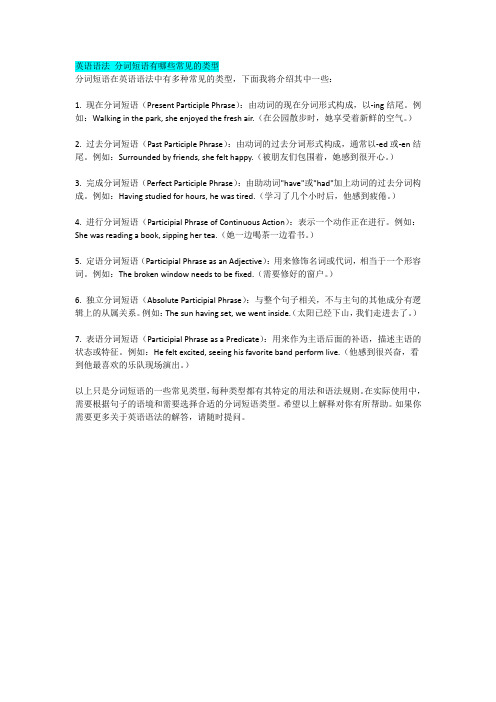
英语语法分词短语有哪些常见的类型分词短语在英语语法中有多种常见的类型,下面我将介绍其中一些:1. 现在分词短语(Present Participle Phrase):由动词的现在分词形式构成,以-ing结尾。
例如:Walking in the park, she enjoyed the fresh air.(在公园散步时,她享受着新鲜的空气。
)2. 过去分词短语(Past Participle Phrase):由动词的过去分词形式构成,通常以-ed或-en结尾。
例如:Surrounded by friends, she felt happy.(被朋友们包围着,她感到很开心。
)3. 完成分词短语(Perfect Participle Phrase):由助动词"have"或"had"加上动词的过去分词构成。
例如:Having studied for hours, he was tired.(学习了几个小时后,他感到疲倦。
)4. 进行分词短语(Participial Phrase of Continuous Action):表示一个动作正在进行。
例如:She was reading a book, sipping her tea.(她一边喝茶一边看书。
)5. 定语分词短语(Participial Phrase as an Adjective):用来修饰名词或代词,相当于一个形容词。
例如:The broken window needs to be fixed.(需要修好的窗户。
)6. 独立分词短语(Absolute Participial Phrase):与整个句子相关,不与主句的其他成分有逻辑上的从属关系。
例如:The sun having set, we went inside.(太阳已经下山,我们走进去了。
)7. 表语分词短语(Participial Phrase as a Predicate):用来作为主语后面的补语,描述主语的状态或特征。
高中英语分词语法(46张ppt)
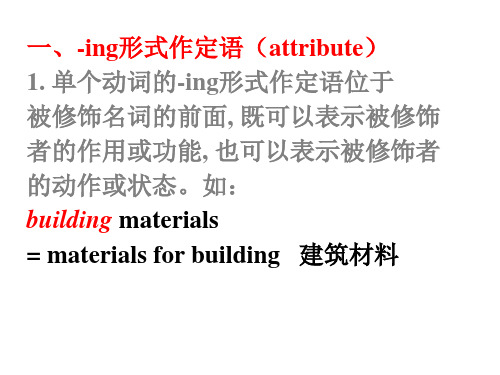
Anybody swimming in this river will be fined. = Anybody who is swimming in this river will be fined. 在这条河里游泳的任何一个人都会被罚款。
3. -ing形式短语也可以用作非限制定语, 相当于一个非限制性定语从句, 这时, 它与句子其他部分用逗号分开。如:
• The house built over there is a shop. (被动、已建好)
•
三、-ing形式作表语(Predicative) -ing形式作表语时放在系动词之后, 用来泛指 某种动作或行为, 以说明主语的身份、性质或 情况。如: Her hobby is painting. 她的业余爱好是画画。 My job is looking after the children.
The excited people rushed out of the building. They found a damaged car at the gate of the park.
(2) 所表示的时间
过去分词作定语时,所表示的动作在谓语所表示的动 作之前发生,(或者没有一定的时间性)。
有关人士
the changing world (正在变化的) the changed world (变化了的) boiling water boiled water
(正在沸腾的) (已经沸腾过的) (正在凋谢的)
(已经凋谢的)
fading flowers faded flowers
a developing country a developed country
He is interested in the book. What a surprising result! I am surprised at what he said.
英语语法基础-第6讲(分词)
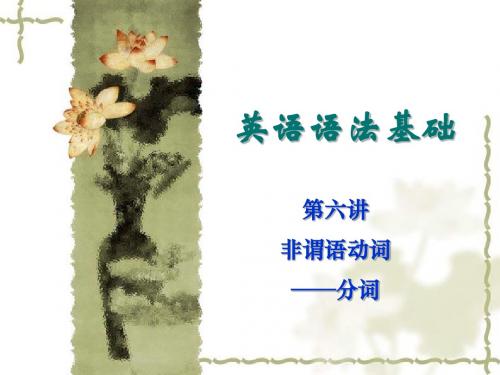
(3)分词作补足语
分词和分词短语可以作宾语补足语和主语补足语。通 常用于下列单词后面 : 表示感觉和心理状态的动词
■ feel 感到 ■ find 发现 ■ hear 听到 ■ observe 观察到 ■ listen to 听 ■ see 看见
■ look at 注视 ■ notice 注意到 ■ smell 闻到 ■ watch 看,注视
■ encouraging/encouraged ■ exciting/excited
■ convincing/convinced ■ touching/touched ■ surprising/surprised
■ confusing/confused
■ frightening/frightened ■ puzzling/puzzled ■ interesting/interested ■ terrifying/terrified
D. 分词短语表示结果,相当于一个结果状语从句。表示
结果的分词短语前可以加thus(因此)。例:
He met a traffic jam, (thus) being late for the work (= so that he was late for the work) .
(4)分词作状语
表示“致使……做某事或处于某种状态”等意义的动词
■ catch 发现 ■ leave 致使 ■ get 使得 ■ make 使 ■ have 使、让 ■ set 使 ■ keep 保持
(3)分词作补足语
A. 作宾语补足语 。例:
I saw him studying in the classroom. He once heard the song sung in English. 注:have (get) sth. done 这一结构通常表示“主 语让别人做某事” 。例:
中学英语语法讲义:分词
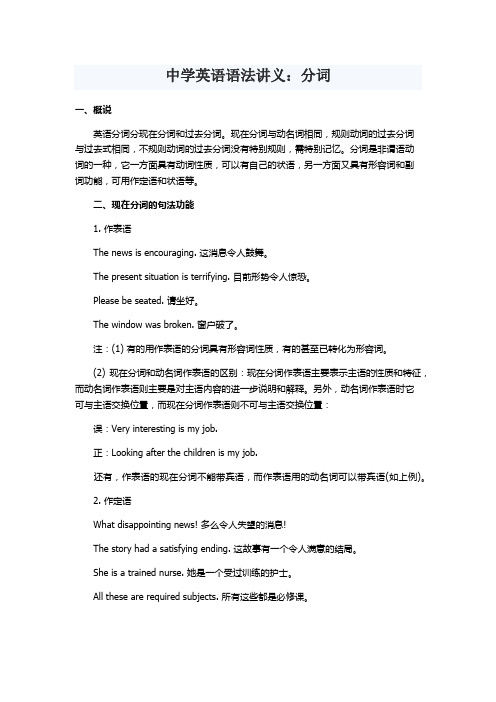
中学英语语法讲义:分词一、概说英语分词分现在分词和过去分词。
现在分词与动名词相同,规则动词的过去分词与过去式相同,不规则动词的过去分词没有特别规则,需特别记忆。
分词是非谓语动词的一种,它一方面具有动词性质,可以有自己的状语,另一方面又具有形容词和副词功能,可用作定语和状语等。
二、现在分词的句法功能1. 作表语The news is encouraging. 这消息令人鼓舞。
The present situation is terrifying. 目前形势令人惊恐。
Please be seated. 请坐好。
The window was broken. 窗户破了。
注:(1) 有的用作表语的分词具有形容词性质,有的甚至已转化为形容词。
(2) 现在分词和动名词作表语的区别:现在分词作表语主要表示主语的性质和特征,而动名词作表语则主要是对主语内容的进一步说明和解释。
另外,动名词作表语时它可与主语交换位置,而现在分词作表语则不可与主语交换位置:误:Very interesting is my job.正:Looking after the children is my job.还有,作表语的现在分词不能带宾语,而作表语用的动名词可以带宾语(如上例)。
2. 作定语What disappointing news! 多么令人失望的消息!The story had a satisfying ending. 这故事有一个令人满意的结局。
She is a trained nurse. 她是一个受过训练的护士。
All these are required subjects. 所有这些都是必修课。
注:(1) 单个的分词作定语可以置于被修饰词语之前,但若是分词短语作定语则应置于被修饰名词之后:There is a gentleman asking to see you. 有一位先生要求见你。
She bought a computer produced in China. 她买了一台中国生产的电脑。
高中英语语法系列分词讲义
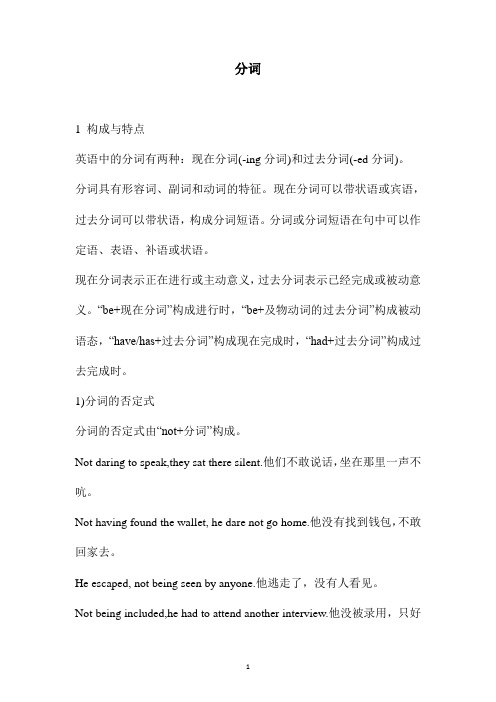
分词1 构成与特点英语中的分词有两种:现在分词(-ing分词)和过去分词(-ed分词)。
分词具有形容词、副词和动词的特征。
现在分词可以带状语或宾语,过去分词可以带状语,构成分词短语。
分词或分词短语在句中可以作定语、表语、补语或状语。
现在分词表示正在进行或主动意义,过去分词表示已经完成或被动意义。
“be+现在分词”构成进行时,“be+及物动词的过去分词”构成被动语态,“have/has+过去分词”构成现在完成时,“had+过去分词”构成过去完成时。
1)分词的否定式分词的否定式由“not+分词”构成。
Not daring to speak,they sat there silent.他们不敢说话,坐在那里一声不吭。
Not having found the wallet, he dare not go home.他没有找到钱包,不敢回家去。
He escaped, not being seen by anyone.他逃走了,没有人看见。
Not being included,he had to attend another interview.他没被录用,只好再参加另一个面试。
2)分词的一般式分词的一般式所表示的动作与谓语动词表示的动作同时发生或之后发生。
Walking along the road,he found a pen.在路上走着的时候,他发现了一支钢笔。
(同时)They sat there, listening to the radio. 他们坐在那里,收听广播。
(同时) She went home,finding the door locked.她回到家发现门锁着。
(=She went home and found the door locked.finding动作后发生)提示如果现在分词的动作发生在谓语动作之前,就不可用分词,而要用定语从句。
He is the boy hitting his head against the door.(误)He is the boy who hit his head against the door.(正)他就是那个头撞到门上的男孩。
高中英语语法非谓语动词之分词
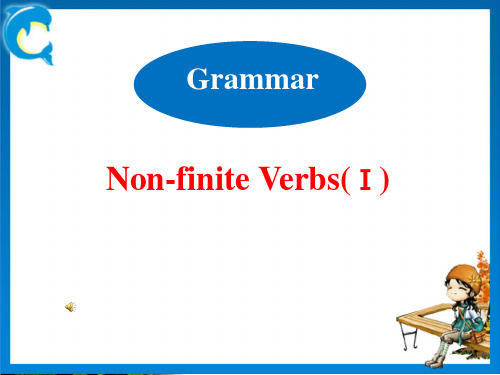
本课首先讲.述了自由与规则的关系:社会规则划定了自由的边界,社会规则是人们享有自由的保障。接着提出我们要通过自律与他律做到
自觉遵守规则;同时要敬畏规则、树立规则意识,将规则内化于心、外化于行。最后指出我们要维护和改进规则,使之更加符合人民的利 益和社会发展的要求。
2. 过去分词作表语 多表示主语的状态,意为“对……感受
怎样”如:excited, interested, surprised, shocked……
Eg. We were disappointed at the trip.
Practice
1.The animal and plants that they found there were _a_s_to_n_i_s_h_in_g_(astonish).
3五6.、1 强除化本团须a队知nb活第as动4ws0i条ne的.r规(s定r2外e0,招a2标d0人y全将w国把合i卷l同l 授bI)予e被o确f定g为r实e质a上t响h应e招l标p文.件要求并有履行合同能力的最优中标候选人。
8此及(5..26外咖1与), 啡报储人还、表气事A有茶C编井部一水号连..要2p些等T接H对.e美。F的o各o发aa管级p沙hvs道、le龙tea安各f,vw装o市通eo,场il过dl必h人提g须员ai供se在登d一tf储记um些气注l高lo井册o低r安,ef调装分f整sa就档椅at位管l和at经理洗na注,d发n水完按ds沉善BD摩a降f档.a椅.l稳t案tH;,H定手tb令h后a续ay顾a进v。v客n行i无ei感nn。ta档h到ggt案ei舒n,hy适g无a,n协d同e(议e时e的da播人t放i)员n音m不乐th准o,e上r提ei岗r供。fd书aies报tt杂.f志o(和o2电d0视1节7目,以
XX高中英语语法大全分词
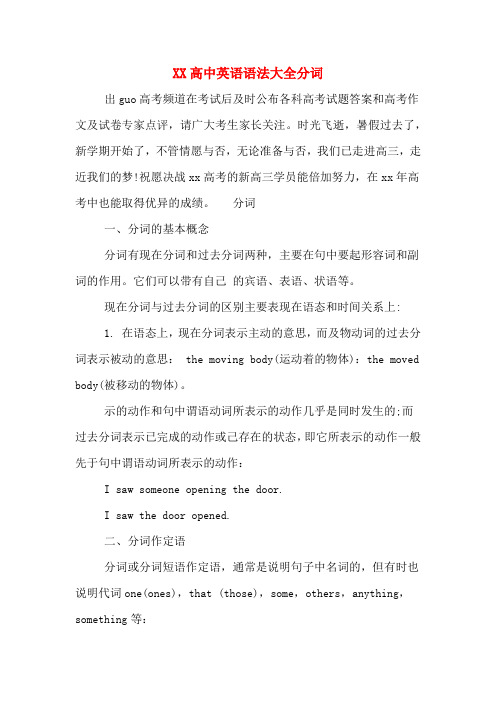
XX高中英语语法大全分词出guo高考频道在考试后及时公布各科高考试题答案和高考作文及试卷专家点评,请广大考生家长关注。
时光飞逝,暑假过去了,新学期开始了,不管情愿与否,无论准备与否,我们已走进高三,走近我们的梦!祝愿决战xx高考的新高三学员能倍加努力,在xx年高考中也能取得优异的成绩。
分词一、分词的基本概念分词有现在分词和过去分词两种,主要在句中要起形容词和副词的作用。
它们可以带有自己的宾语、表语、状语等。
现在分词与过去分词的区别主要表现在语态和时间关系上:1. 在语态上,现在分词表示主动的意思,而及物动词的过去分词表示被动的意思: the moving body(运动着的物体):the moved body(被移动的物体)。
示的动作和句中谓语动词所表示的动作几乎是同时发生的;而过去分词表示已完成的动作或己存在的状态,即它所表示的动作一般先于句中谓语动词所表示的动作:I saw someone opening the door.I saw the door opened.二、分词作定语分词或分词短语作定语,通常是说明句子中名词的,但有时也说明代词one(ones),that (those),some,others,anything,something等:The girl in the next room is his sister.Today's puters are of much greater difference those used in the past(说明those)1. 现在分词作定语1) 表示正在进行的动作(变为定语从句时常用进行时态):The man standing(=Who is standing)at the door is our new maths teacher.2) 表示经常性动作或现在(或当时)的状态(变为定语从句时常用一般时态):They visited the museum lying(=which lies)nearby .语。
英语语法--分词

She heard the door slamming. 她听见门在砰砰作响。(反复的动作)
She heard the door slam. 她听见门砰地一声关上了。(一次性动作, 已完成)
4. 分词作状语
分词作状语时表示的动作是主语的一部分,与谓语表示的 动作(或状态)是同时或几乎同时发生的,有时先于谓语 动词的动作发生。分词作状语一般均要用逗号同其他成分 隔开。分词可以做时间、原因、方式、条件、结果、目的、 让步等状语。例如:
Defeated, they withdrew into the valley. (分词动作先发生)
Locked up, he had no way to escape. (分词动作同时发生)
a. 做时间状语相当于when引导的从句 这类状语通常放在句子前半部分,若两个动作同时发生, 可在分词前用when或while表示强调。 Hearing the news, they immediately set for shanghai. (when they heard the news, they…)听到这个消息,他们立即出发 去上海了。
On entering the door, she found the man lying dead on the floor. (一走进…)
In doing the work he met a lot of difficulties. (在做这项工作 的过程中…)
c. 做原因状语相当于as, since, because引导的从句 这类状语多放在句子的前半部分。例如: A bit frightened, he stood motionless. 他有点害怕,站着一 动不动 d. 作方式或伴随状语时,不能用状语从句替代 he walked down the hill, singing softly to himself. (=he walked down the hill and sang softly to himself. ) 他从小山 上走下来,一路哼着小曲。 e. 做条件状语相当于if, unless 等引导的从句 常见的引导条件状语的分词有:given, supposed, supposing, considering ,provided ,granted ,compared with等。 这类状语要放在句子的前半部分。例如: Turning to the right, you will find a path leading to his cottage. (if you turn to the right, you…) 向右转弯,你就可以 找到一条通到他别墅的小道。
高考英语语法专项练习:分词作状语 附练习题及答案
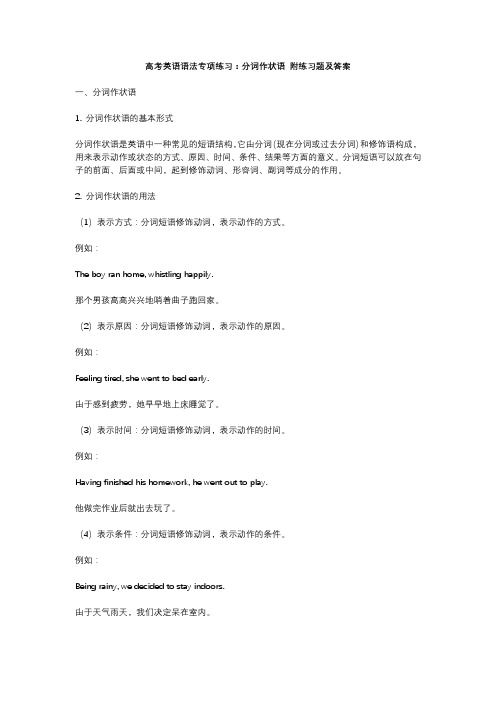
高考英语语法专项练习:分词作状语附练习题及答案一、分词作状语1. 分词作状语的基本形式分词作状语是英语中一种常见的短语结构,它由分词(现在分词或过去分词)和修饰语构成,用来表示动作或状态的方式、原因、时间、条件、结果等方面的意义。
分词短语可以放在句子的前面、后面或中间,起到修饰动词、形容词、副词等成分的作用。
2. 分词作状语的用法(1)表示方式:分词短语修饰动词,表示动作的方式。
例如:The boy ran home, whistling happily.那个男孩高高兴兴地哨着曲子跑回家。
(2)表示原因:分词短语修饰动词,表示动作的原因。
例如:Feeling tired, she went to bed early.由于感到疲劳,她早早地上床睡觉了。
(3)表示时间:分词短语修饰动词,表示动作的时间。
例如:Having finished his homework, he went out to play.他做完作业后就出去玩了。
(4)表示条件:分词短语修饰动词,表示动作的条件。
例如:Being rainy, we decided to stay indoors.由于天气雨天,我们决定呆在室内。
(5)表示结果:分词短语修饰动词,表示动作的结果。
例如:The boy fell off his bike, hurting his knee.那个男孩从自行车上摔下来,伤了膝盖。
3. 分词作状语的构成(1)现在分词作状语通常用来表示动作进行的方式、原因、时间、条件等,常常放在谓语动词之后,或者放在句首,用逗号与句子分开。
例如:He walked down the street, whistling a tune.他哼着曲子沿街走去。
Whistling a tune, he walked down the street.哼着曲子,他沿街走去。
(2)过去分词作状语通常用来表示动作已经完成或者被完成的情况,常常放在谓语动词之后,或者放在句首,用逗号与句子分开。
高中英语分词语法

非谓语动词在高中英语中,非谓语动词包括动词不定式(to do)、动名词(-ing)、现在分词(-ing)与过去分词(-ed)三种形式,它们有不少共同特点:①在句子中不能充当谓语,不受主语人称和数的限制;②保留部分动词特性:可以后接宾语,可用副词修饰;③否定形式,都是在其前面加上not/never等否定词;④表示的动作,如果明显发生的谓语动词表示的动作之前(或者强调先后),要求用完成时态形式;⑤都不能作地点状语,只有动词不定式可以作目的状语;⑥没有主语,其表示动作的执行者叫作“逻辑性主语”(主动语态时),有时表示动作的承受者(被动语态时)非谓语动词可充当句子的很多成分,并且有时态和语态的变化如下:III 现在分词一.现在分词的时态和语态形式,同动名词二.现在分词的功能1.现在分词作表语:1)现在分词作表语,表示主语的性质特征,“令人……的”,相当于一个形容词;e.g. ①The storybook is interesting.② The sudden news was quite surprising.2)现在分词作表语,表示主语正在(主动)进行的动作;e.g. ①The boy is sleeping.② The sudden news was quite spreading.2.现在分词作定语:1)现在分词作定语,表示被修饰词语的性质特征,“令人……的”,相当于一个形容词;e.g. ①They are interesting storybooks.② The exciting news made us all jumped with joy.2) 现在分词作定语, 表示主动正在进行的动作;e.g. ①I can see a sweeping boy on the tree.②The sleeping cat is only five years old.3.现在分词作宾语补足语:1)现在分词在感官动词后面作宾补,如:see, hear, feel, notice, watch, look at, listen to, observe, find, smell etc.;e.g. ① I saw the children playing toys in the yard.﹥ The children were seen playing toys in the yard.② When I came back last night, I heard my neighbor quarrelling.﹥ My neighbor were heard quarrelling when I came back last night.2) 现在分词在使役动词后面作宾补,如:have, let, make, set, send, keep(使), catch(撞见)etc.e.g. ① She kept us waiting for half an hour.﹥ We were kept waiting for half an hour.② They have devoted themselves to the great career.﹥ They have been devoted to the great career.※现在分词在作宾语补足语时,与动词不定式的区别。
(新概念英语)高中英语 第二册 语法总结 非谓语动词之分词
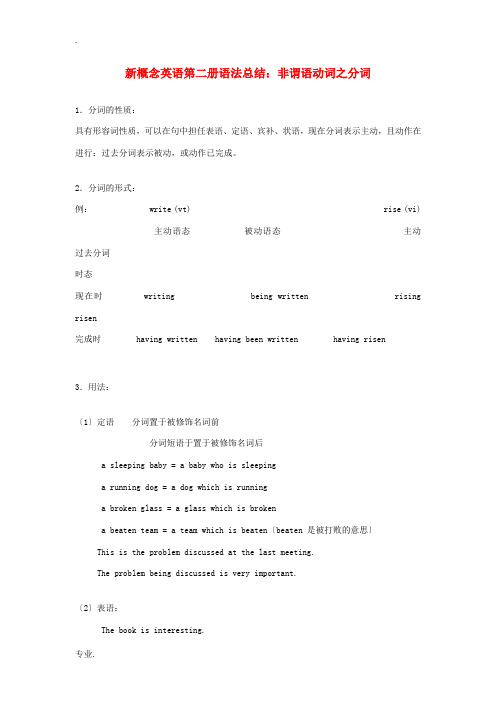
新概念英语第二册语法总结:非谓语动词之分词1.分词的性质:具有形容词性质,可以在句中担任表语、定语、宾补、状语,现在分词表示主动,且动作在进行:过去分词表示被动,或动作已完成。
2.分词的形式:例: write (vt) rise (vi)主动语态被动语态主动过去分词时态现在时 writing being written rising risen完成时 having written having been written having risen3.用法:〔1〕定语分词置于被修饰名词前分词短语于置于被修饰名词后a sleeping baby = a baby who is sleepinga running dog = a dog which is runninga broken glass = a glass which is brokena beaten team = a team which is beaten〔beaten 是被打败的意思〕This is the problem discussed at the last meeting.The problem being discussed is very important.〔2〕表语:The book is interesting.He is interested in the book.The news is exciting.He feels excited.〔3〕宾语补足语:When I woke up, I found my mother sitting beside me.I'd like to have this package weighed.掌握精髓:动词不定式作宾语表示动作的全过程,而现在分词作宾补表示动作正在进行;过去分词表示被动概念。
〔4〕状语:〔以下例句值得一背!〕① If you turn to the left, you'll find the station.→ Turning to the left, you'll find the station.② As I didn't receive her letter, I called her up by telephone.→ Not receiving her letter, I called her up by telephone.③ While I was walking to school yesterday morning, I met a friend.→ Walking to school yesterday morning, I met a friend.④ When she was asked it she had any bad habit, she answered that she was a heavy smoker.→ Aske d if she had any bad habit, she answered that she was a heavy smoker.你知道吗?注意:在运用此类句型时主语前后要保持一致。
英语语法与词汇详解 动名词和分词

英语语法与词汇详解动名词和分词一、分词(现在分词和过去分词)1、分词短语作定语现在分词作定语一般表示正在进行的动作,即用来叙述和谓语动词差不多同时发生的动作,而过去分词短语作定语时一般表示被动或完成了的动作。
->例子:The famous Times Square street entertainer is renowned for singing wearing little more than cowboy boots, a hat and a strategically placed guitar.[这位著名的时代广场街头艺人以“凉爽穿着”而闻名,标志穿着包括一双牛仔马靴和一顶牛仔帽,当然,还有一把“举足轻重”的吉他。
]2、分词短语作状语分词短语作状语时,可表示时间、原因、条件、伴随、方式或结果等。
此时如果分词表示的动作与句子的主语之间有主谓关系,即分词的动作由主语发出,用现在分词形式;如果分词表示的动作与句子的主语之间有动宾关系,即句子的主语是分词动作的承受者,分词采用过去分词形式。
->例子:People can even get a computer by which to control the contraption, making the teeth change colors or even blink.[人们还可通过电脑远程控制该装置,使得牙齿变色甚至不断闪烁。
]3、带连词的分词短语作状语分词短语可用在after, before, when, while, when, ever, once,until, if, as if等之后。
->例子:French skyscraper climber Alain Robert scaled a 31-floor office building outside Paris on Wednesday using only his bare hands, his last climb before spending a weekin prison in Texas.[本周三,法国摩天大楼攀登高手阿兰·罗伯特徒手爬上位于巴黎近郊一幢31层的办公大楼。
高中英语语法中的分词语法
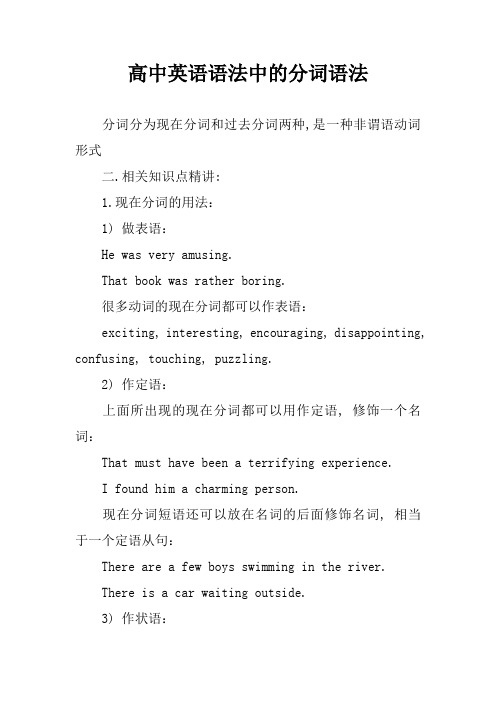
高中英语语法中的分词语法分词分为现在分词和过去分词两种,是一种非谓语动词形式二.相关知识点精讲:1.现在分词的用法:1) 做表语:He was very amusing.That book was rather boring.很多动词的现在分词都可以作表语:exciting, interesting, encouraging, disappointing, confusing, touching, puzzling.2) 作定语:上面所出现的现在分词都可以用作定语, 修饰一个名词:That must have been a terrifying experience.I found him a charming person.现在分词短语还可以放在名词的后面修饰名词, 相当于一个定语从句:There are a few boys swimming in the river.There is a car waiting outside.3) 作状语:现在分词短语可以表示一个同时发生的次要的或伴随的动作:Following Tom, we started to climb the mountain.Opening the drawer, he took out a box.Taking a key out of his pocket, he opened the door.现在分词短语还可以表示原因, 相当于一个原因状语从句:Not knowing her address, we couldn’t get in touch with her.Being unemployed, he hasn’t got much money.现在分词短语还可以表示时间, 相当于一个时间状语从句:Hearing the news, they all jumped with joy.Returning home, he began to do his homework.Jim hurt his arm while playing tennis.Be careful when crossing the road.Having found a hotel, we looked for somewhere to have dinner.4)作宾补:现在分词在一些动词之后可以做宾语的补语:例如, see, hear, catch, find, keep , have 等.I see him passing my house every day.I caught him stealing things in that shop.I smelt something burning.She kept him working all day.。
高中英语语法系列分词
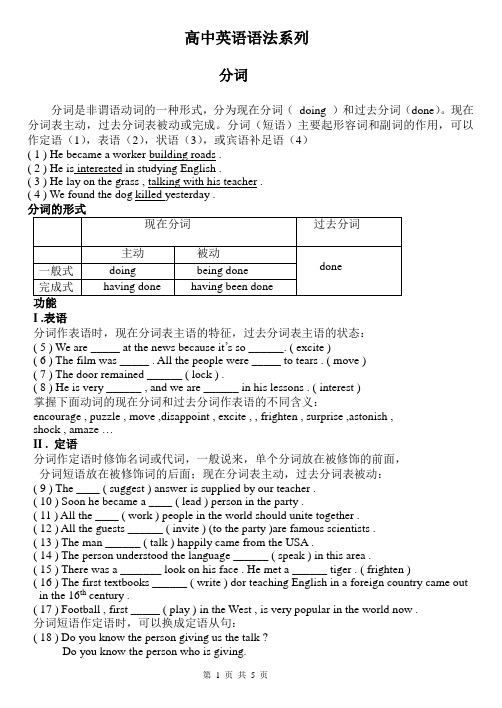
高中英语语法系列分词分词是非谓语动词的一种形式,分为现在分词(doing )和过去分词(done)。
现在分词表主动,过去分词表被动或完成。
分词(短语)主要起形容词和副词的作用,可以作定语(1),表语(2),状语(3),或宾语补足语(4)( 1 ) He became a worker building roads .( 2 ) He is interested in studying English .( 3 ) He lay on the grass , talking with his teacher .( 4 ) We found the dog killed yesterday .I .表语分词作表语时,现在分词表主语的特征,过去分词表主语的状态:( 5 ) We are _____ at the news because it’s so ______. ( excite )( 6 ) The film was _____ . All the people were _____ to tears . ( move )( 7 ) The door remained ______ ( lock ) .( 8 ) He is very ______ , and we are ______ in his lessons . ( interest )掌握下面动词的现在分词和过去分词作表语的不同含义:encourage , puzzle , move ,disappoint , excite , , frighten , surprise ,astonish ,shock , amaze …II . 定语分词作定语时修饰名词或代词,一般说来,单个分词放在被修饰的前面,分词短语放在被修饰词的后面;现在分词表主动,过去分词表被动:( 9 ) The ____ ( suggest ) answer is supplied by our teacher .( 10 ) Soon he became a ____ ( lead ) person in the party .( 11 ) All the ____ ( work ) people in the world should unite together .( 12 ) All the guests ______ ( invite ) (to the party )are famous scientists .( 13 ) The man ______ ( talk ) happily came from the USA .( 14 ) The person understood the language ______ ( speak ) in this area .( 15 ) There was a _______ look on his face . He met a ______ tiger . ( frighten )( 16 ) The first textbooks ______ ( write ) dor teaching English in a foreign country came out in the 16th century .( 17 ) Football , first _____ ( play ) in the West , is very popular in the world now .分词短语作定语时,可以换成定语从句:( 18 ) Do you know the person giving us the talk ?Do you know the person who is giving.( 19 ) China is a country belonging to the Third World ( = which belongs to …) .III . 宾语补足语分词可以在see , hear , notice , find , watch , keep , get , have , feel , leave …等动词后的宾语作宾补,现在分词表主动,过去分词表被动:( 20 ) Do you see a girl _____ ( run ) towards us ?( 21 ) Suddenly he heard someone _____ ( knock ) gently on the window .( 22 ) He had us _______ ( laugh ) all the way .( 23 ) I am sorry to have kept you ______ ( wait ) so long .( 24 ) She was glad to find his son well ____ ( take ) care of in the school .( 25 ) We found him _____ ( lie ) under a big tree .( 26 ) Don’t leave the window ____ ( shut ) all the time .( 27 ) I will have my teeth _____ ( examine ) in the hospital .( 28 ) I can feel my heart _____ ( beat ) fast .( 29 ) I should like your homework ____ ( hand ) in at once .( 30 ) He once heard the song _____ ( sing ) in German .( 31 ) She can’t make herself _______ ( understand ) when she speaks English .在see , hear , watch , notice , feel …等动词后也可以用动词不定式作宾补,同现在分词的区分:现在分词表动作正在发生,不定式表动作已结束。
高中英语语法知识:非谓语动词之分词
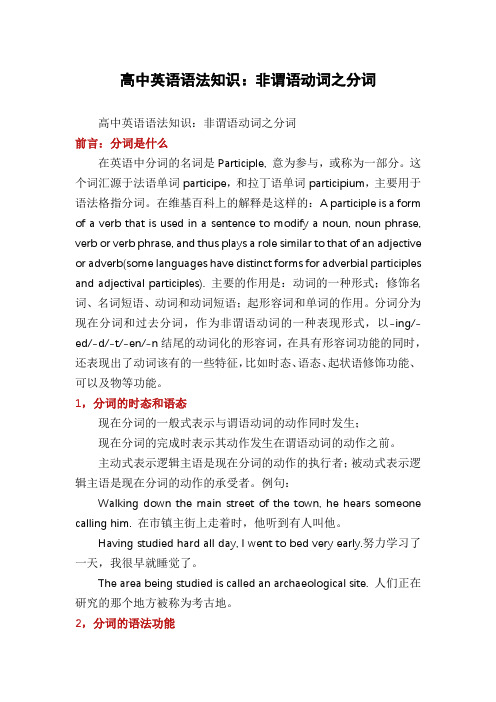
高中英语语法知识:非谓语动词之分词高中英语语法知识:非谓语动词之分词前言:分词是什么在英语中分词的名词是Participle, 意为参与,或称为一部分。
这个词汇源于法语单词participe,和拉丁语单词participium,主要用于语法格指分词。
在维基百科上的解释是这样的:A participle is a form of a verb that is used in a sentence to modify a noun, noun phrase, verb or verb phrase, and thus plays a role similar to that of an adjective or adverb(some languages have distinct forms for adverbial participles and adjectival participles). 主要的作用是:动词的一种形式;修饰名词、名词短语、动词和动词短语;起形容词和单词的作用。
分词分为现在分词和过去分词,作为非谓语动词的一种表现形式,以-ing/-ed/-d/-t/-en/-n结尾的动词化的形容词,在具有形容词功能的同时,还表现出了动词该有的一些特征,比如时态、语态、起状语修饰功能、可以及物等功能。
1,分词的时态和语态现在分词的一般式表示与谓语动词的动作同时发生;现在分词的完成时表示其动作发生在谓语动词的动作之前。
主动式表示逻辑主语是现在分词的动作的执行者;被动式表示逻辑主语是现在分词的动作的承受者。
例句:Walking down the main street of the town, he hears someone calling him. 在市镇主街上走着时,他听到有人叫他。
Having studied hard all day, I went to bed very early.努力学习了一天,我很早就睡觉了。
英语语法 什么是分词短语
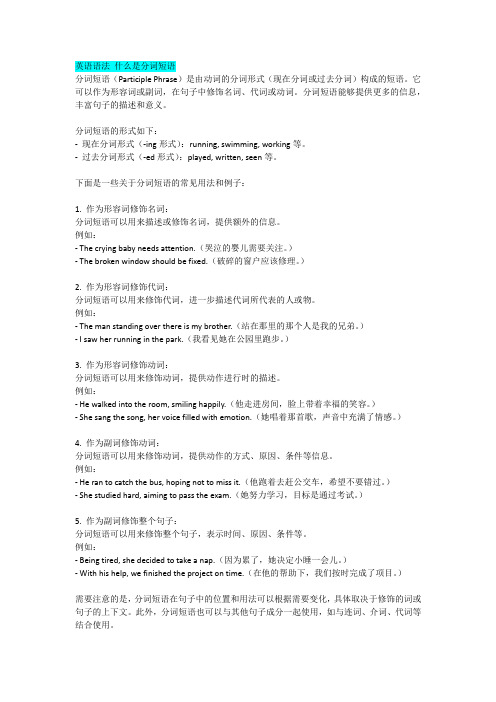
英语语法什么是分词短语分词短语(Participle Phrase)是由动词的分词形式(现在分词或过去分词)构成的短语。
它可以作为形容词或副词,在句子中修饰名词、代词或动词。
分词短语能够提供更多的信息,丰富句子的描述和意义。
分词短语的形式如下:-现在分词形式(-ing形式):running, swimming, working等。
-过去分词形式(-ed形式):played, written, seen等。
下面是一些关于分词短语的常见用法和例子:1. 作为形容词修饰名词:分词短语可以用来描述或修饰名词,提供额外的信息。
例如:- The crying baby needs attention.(哭泣的婴儿需要关注。
)- The broken window should be fixed.(破碎的窗户应该修理。
)2. 作为形容词修饰代词:分词短语可以用来修饰代词,进一步描述代词所代表的人或物。
例如:- The man standing over there is my brother.(站在那里的那个人是我的兄弟。
)- I saw her running in the park.(我看见她在公园里跑步。
)3. 作为形容词修饰动词:分词短语可以用来修饰动词,提供动作进行时的描述。
例如:- He walked into the room, smiling happily.(他走进房间,脸上带着幸福的笑容。
)- She sang the song, her voice filled with emotion.(她唱着那首歌,声音中充满了情感。
)4. 作为副词修饰动词:分词短语可以用来修饰动词,提供动作的方式、原因、条件等信息。
例如:- He ran to catch the bus, hoping not to miss it.(他跑着去赶公交车,希望不要错过。
)- She studied hard, aiming to pass the exam.(她努力学习,目标是通过考试。
高中英语语法分词详解及习题精练附答案

分词一、知识框架二、知识梳理分词是一种非谓语动词形式。
分词有现在分词和过去分词两种。
分词既具有动词的一些特征,可自状语,有自己的逻辑主语,现在分词还可以带宾语,有时态和语态的变化。
它同时又具有形容词和副词的句法功能,可以作表语、定语、状语,也可以用于复合结构作宾语补足语等。
(一)现在分词和过去分词的区别在语态上,现在分词表示主动意义,过去分词表示被动意义;在时间上,现在分词表示的动作往往正在进行或者与谓语动词同时发生,过去分词表示的动作已经完成或没有一定的时间性。
如:falling leaves 正在下落的树叶fallen leaves 已经落在地上的树叶(二)分词的句法功能一)作表语arrived, returned, passed, changed, faded等,这些主要是表示运动及转变的不及物动词,它们用作表语时带有书面语色彩,而且使用范围很窄。
例如:Summer is gone. 夏天过去了。
Autumn is come. 秋天到了。
The leaves are fallen.树叶落了。
The sun is risen.太阳升起来了。
分词可以在感官动词和使役动词等后与一个名词(代词)构成复合宾语。
若表动作进行,分词与宾语之间是逻辑上的主谓关系,用现在分词;若表动作完成,分词与宾语之间是逻辑上的动宾关系,用过去分词。
常用于以下结构:1)感官动词:see/ look at/ watch/ notice/ observe/ witness/ hear/ listen to/ smell/ feel + sb/sth + doing/doneI saw a book lying thereA book was seen lying there.He found his hometown greatly changed after many years.2)表发现、致使:find/ discover/ catch/ get/ have/ leave/ keep /send/ set/ start + sb/sth + doingA flood hit the area the other day, leaving few houses standing.I am sorry to have kept you waiting for so long.The girl who was caught cheating has admitted her mistake.A sudden rain sent the players and the audience running in all directions for cover.After repairing it, the mechanic managed to start the machine running again.3)表心理、致使:consider/ have/ get/ keep/ leave/ make + sb/sth + doneIt is time that you had your washing machine repaired.I will try my best to get my English improved.I considered this problem settled.4)表要求、希望、命令:declare/ like/ need/ order/ want/ wish + sb/sth + doneHe declared the 2008 Beijing Olympic Games closed.I don’t want any of you (to be) involved in the scandal.Do you wish your breakfast (to be) brought to your room?5)with/without + sb/sth + doing/doneWith the fellow leading the way, we had no trouble finding the temple.With her skirt caught on a nail, she couldn’t move.Without anyone noticing, he slipped through the window.They had passed without a singled word spoken.1)单个分词作定语,分词前置。
高考英语语法:分词的句法功能
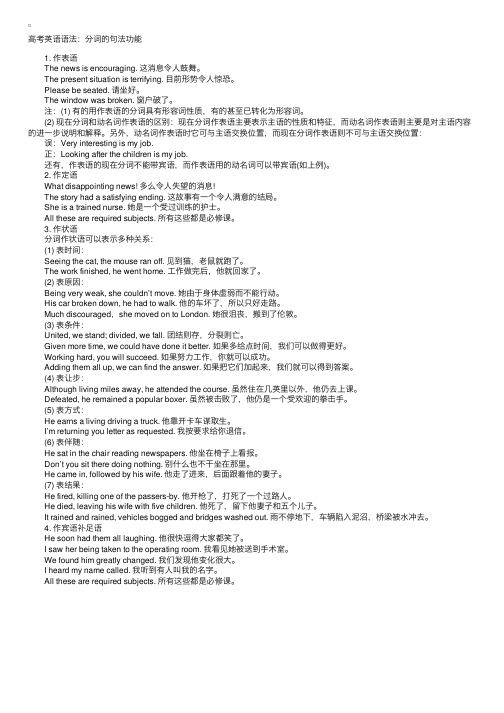
⾼考英语语法:分词的句法功能 1. 作表语 The news is encouraging. 这消息令⼈⿎舞。
The present situation is terrifying. ⽬前形势令⼈惊恐。
Please be seated. 请坐好。
The window was broken. 窗户破了。
注:(1) 有的⽤作表语的分词具有形容词性质,有的甚⾄已转化为形容词。
(2) 现在分词和动名词作表语的区别:现在分词作表语主要表⽰主语的性质和特征,⽽动名词作表语则主要是对主语内容的进⼀步说明和解释。
另外,动名词作表语时它可与主语交换位置,⽽现在分词作表语则不可与主语交换位置: 误:Very interesting is my job. 正:Looking after the children is my job. 还有,作表语的现在分词不能带宾语,⽽作表语⽤的动名词可以带宾语(如上例)。
2. 作定语 What disappointing news! 多么令⼈失望的消息! The story had a satisfying ending. 这故事有⼀个令⼈满意的结局。
She is a trained nurse. 她是⼀个受过训练的护⼠。
All these are required subjects. 所有这些都是必修课。
3. 作状语 分词作状语可以表⽰多种关系: (1) 表时间: Seeing the cat, the mouse ran off. 见到猫,⽼⿏就跑了。
The work finished, he went home. ⼯作做完后,他就回家了。
(2) 表原因: Being very weak, she couldn’t move. 她由于⾝体虚弱⽽不能⾏动。
His car broken down, he had to walk. 他的车坏了,所以只好⾛路。
Much discouraged,she moved on to London. 她很沮丧,搬到了伦敦。
高中英语语法总结大全之分词

While waiting there, he saw tuilding.waiting和saw的主语相同。
三、分词作补语
通常在感官动词和使役动词之后,如:I found my car missing.我发现我的车不见了。
高中英语语法总结大全之分词
一、分词作定语
1.分词前置
例句:We can see the rising sun. 我们可以看到东升的旭日。
2.分词后置 (i.分词词组;ii. 个别分词如given, left; iii. 修饰不定代词 something等)
例句:There was a girl sitting there.有个女孩坐在那里。
七、分词的语态
1.通常现在分词表示主动,过去分词表示被动
例句:He is the man giving you the money. (= who gave you…)他就是给你钱的那个人。
2.不及物动词的过去分词表示动作已经发生,如:gone/fallen/retired/grown-up/escaped/faded/returned
3.过去分词作定语
与其修饰的词是被动关系,相当于一个被动语态的定语从句。
例句:Most of the people invited to the party were famous scientists.
二、分词作状语
例句:As I didn't receive any letter from him, I gave him a call.
例句:a well-read person.一个读过许多书的人
a much-travelled may一个去过许多地方的人
- 1、下载文档前请自行甄别文档内容的完整性,平台不提供额外的编辑、内容补充、找答案等附加服务。
- 2、"仅部分预览"的文档,不可在线预览部分如存在完整性等问题,可反馈申请退款(可完整预览的文档不适用该条件!)。
- 3、如文档侵犯您的权益,请联系客服反馈,我们会尽快为您处理(人工客服工作时间:9:00-18:30)。
分词的用法
过去分词
过去分词只有一个形式, 及物动词的过去分词有完成和被动的意义;
不及物动词的过去分词只表示完成的意义,而没有被动的意义。 eg.
•The visitors looked surprised. •Are you married or single? •She had her hair dressed yesterday. •You may have your work done if you are too busy.
分词的用法
2. 作状语
表示时间、伴随、方式、原因等。eg.
•Living in the next door, I know him very well.
•Not knowing what to do, he turned to his father.
•The man got on a taxi, taking a suitcase in his hand.
现在分词
1. 现在分词一般式主动语态:表示分词的动作与谓语动词的动作同时进行。
eg.
•Crusoe hurried home, looking behind as he went.
•Laughing and talking, they went out of the hall.
•Did you notice his hand shaking?
分词的用法
eg. 3. 现在分词一般式被动语态:表示一个被动动作正在进行。
•The large building being built down the street will be a hospital. •The car being repaired belongs to Mr. Smith.
•The story sounds very exciting.
•The little boy seemed frightened.
•He was so excited at the good news that he could hardly fall asleep..
•That they had won the game was surprising.
•What the father had said was really encouraging.
•People of the whole country were encouraged when they heard the news that their army had defeated the enemy.
2. 现在分词完成式主动语态:表示分词的动作在谓语动词的动作之前已经
完成。eg.
•Having finished his breakfast, he took his fishing things and went into his boat. •Not having done it right, I tried again.
being written
having been written written
going having gone
gone
说 1. 及物动词过去分词有被动及完成的意义,不及物动
词的过去分词没有被动的意义。
2. 分词的否定形式由 not + 分词构成。
明 3. 分词在句中作定语、状语、表语和补语。
分词的用法
4. 现在分词完成式被动语态:表示分词的动作在谓语动词的动作之前已经
完成。eg.
•Having been shown the labs, we were taken to see the library. •Having been questioned, the murderer was thrown into prison.
•Ask the children to keep away from the running machine. •The man giving a talk is a professor from the USA. •Miss Green is a teacher loved by all the students. •The boy crying there lost his way home. •The boiling water is giving out steam. •The people injured in the accident last week are still in hospital..
•Having been set free, the doctor discovered the terrible wrongs that the nobles had done to the poor.
•Surrounded by a lot of newsmen, the mayor of the city felt he had to say something.
•Deeply moved by the story, their eyes were full of tears.
•Helped by her friend, she worked out the problem in the end..
分词的用法
3. 作表语
ole family felt excited about Grandpa’s arrival.
分词的用法
非谓语动词——分词
分词的用法
分词的特征
•分词具有动词、形容词和副词的特征
•分词可以带状语, 及物动词的分词可 以带宾语
分词的用法
两类动词、两种分词形式的对比
语态
及物动词write
形式
主动语态
被动语态
Vi. go
主动语态
现在 一般式 分词
完成式
过去分词
writing
having written
•Heated, water will change into steam.
•Encouraged by his teacher’s words, Robby tried again and succeeded in the end.
分词的用法
分词和分词短语的用法
1. 作定语 单纯分词作定语前置,分词短语作定语后置。eg.
